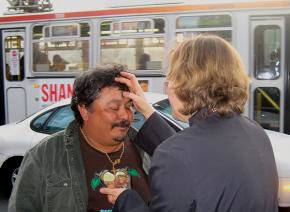Witness to the dark: Ashes in the streets

Here’s how our new tradition got started. Back in 2009, at the urging of the diocesan office where the young priest Bertie Pearson was working, Episcopal churches in San Francisco’s Mission District met to discuss possible joint projects. Bertie had pink cheeks and a sweet, pale face with swept-back, jet-black hair; in his formal black clericals he looked like a choirboy dressed up as Johnny Cash. A former DJ and drummer in the Mission music scene, Bertie was completely respectful of tradition, a real believer and still a punk at heart—a punk for God.
Bertie’s mentor at Church of the Advent had suggested creating an outdoor processional liturgy as “a public act of repentance” for homelessness and street violence and holding it on Good Friday. “You know, the Anglo-Catholics love processions,” Bertie said. “So folks from Advent, St. John’s, Holy Innocents and St. Gregory’s, and I think the Franciscans, did that 2009 Good Friday walk.”
That day we covered a lot of ground, walking from one end of the Mission to the other, stopping to chant prayers at places where people had been murdered or at sites of suffering designated as “stations of the cross.” We prayed at the police station, in a garbage-filled park where a boy had been shot, in front of a homeless shelter. Some in our group—about 40 men and women and a couple of small children—chatted as we strolled, while others seemed lost in their own meditations. A nun in a brown Franciscan habit carried a large photograph of a bound, blindfolded, kneeling Iraqi prisoner with a duct-taped wound in his side; two women in sweatshirts took turns carrying a heavy cross; and a couple of thurifers censed storefronts and passersby enthusiastically. Most onlookers smiled, and a few fell in step with us at different points, joining in the hymns. In this neighborhood, an outdoor Good Friday commemoration wasn’t entirely unusual.




